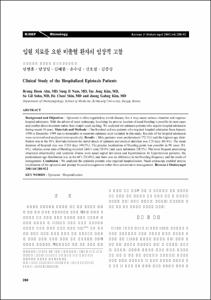KUMEL Repository
1. Journal Papers (연구논문)
1. School of Medicine (의과대학)
Dept. of Otorhinolaryngology (이비인후과학)
입원 치료를 요한 비출혈 환자의 임상적 고찰
- Keimyung Author(s)
- Ahn, Byung Hoon; Nam, Sung Il; Kim, Joong Gahng
- Department
- Dept. of Otorhinolaryngology (이비인후과학)
- Journal Title
- 대한이비인후과학회지
- Issued Date
- 2001
- Volume
- 44
- Issue
- 3
- Abstract
- Background and Objectives:Epistaxis is often regarded as trivial disease, but it may cause serious situation and requires hospital admission. With the advent of nasal endoscopy, localizing the precise location of nasal bleeding is possible in most cases and enables direct treatment rather than simple nasal packing. We analyzed the epistaxis patients who require hospital admission during recent 10 years. Materials and Methods:One hundred and one patients who required hospital admission from January 1990 to December 1999 due to intractable or recurrent epistaxis were included in this study. Records of the hospital admission were reviewed and analyzed retrospectively. Results:Male patients were predominant (72.1%) and the highest age distribution was in the 50’s. Intervals between the initial attack of epistaxis and medical attention was 2-5 days (60.4%). The mean duration of hospital stay was 5-10 days (49.5%). The precise localization of bleeding point was possible in 98 cases (81.6%), whereas some sites of bleeding revealed Little’s area (35.0%) and nasal turbinates (28.3%). The most frequent preexisting structural abnormality and systemic illness were nasal septal deviation and hypertension. In hypertension patients, the predominant age distribution was in the 60’s (28.6%), and there was no difference in the bleeding frequency and the mode of management. Conclusion:We analyzed the epistaxis patients who required hospitalization. Nasal endoscopy enabled precise localization of the epistaxis and prompt focused management rather than conservative management.
- Alternative Title
- Clinical Study of the Hospitalized Epistaxis Patients
- Publisher
- School of Medicine
- Citation
- 안병훈 et al. (2001). 입원 치료를 요한 비출혈 환자의 임상적 고찰. 대한이비인후과학회지, 44(3), 288–292.
- Type
- Article
- ISSN
- 1225-035X
- Appears in Collections:
- 1. School of Medicine (의과대학) > Dept. of Otorhinolaryngology (이비인후과학)
- 파일 목록
-
-
Download
 oak-bbb-03176.pdf
기타 데이터 / 219.93 kB / Adobe PDF
oak-bbb-03176.pdf
기타 데이터 / 219.93 kB / Adobe PDF
-
Items in Repository are protected by copyright, with all rights reserved, unless otherwise indicated.